Posted by Elena del Valle on January 19, 2021

The Climate Crisis Font English language landing page – click to enlarge
Video, photos: Helsingin Sanomat
Photo Tuomas Jääskeläinen: Juha Törmälä
Helsingin Sanomat
, “the biggest subscription-based newspaper in the Nordics,” dedicated several weeks of work spread over months to the development of The Climate Crisis Font designed to visualize the urgency for climate action. The new font is available for download free of charge at TypeToAct.com. Scroll down to watch an English language video.
“The font has been licensed with SIL Open Font licensing making it available for editorial, commercial, and private use,” said Tuomas Jääskeläinen, art director, Helsingin Sanomat, in response to questions through a communications intermediary via email.” The full terms of use are available at drive.google.com/file/d/19M8ebCT0JOLWln6LDkWQzj5gy-qmj9Ww/view.

The Climate Crisis Font designed to visualize the urgency for climate action – click to enlarge
“The main limitation is that it needs to be kept freely available and free of charge,” he said. “The font is intended for anyone who wishes to make a point about the impact of climate change, be it the media, designers, artists, activists or anyone else.” He explained that “the font has been designed to work in all latin-based alphabets when it comes to e.g. diacritics.
.
When asked other than drawing attention to climate action what makes the font special or distinctive he replied: “
I think it’s the fact that it’s based on actual data. We haven’t done a massive search, but I suspect it’s among the first data-based fonts in the world, if not the first. That, and the way the scalable OpenType technology lets the font align with the yearly data, is what makes it special for me.”

Tuomas Jääskeläinen, art director, Helsingin Sanomat
Regarding the budget or budget range for the creation of the font he said: “
Unfortunately I cannot disclose the budget, but it is a reasonable investment considering the scope of work needed.”
Helsingin Sanomat, a private for profit entity, is published by Sanoma Media Finland, a leading Finnish multi-channel media company. The paper’s primary language is Finnish.
Posted by Elena del Valle on August 13, 2018

Andrew Conte, director, Center for Media Innovation, Point Park University
Photo: Point Park University
A podcast interview with Andrew Conte, director, Center for Media Innovation, Point Park University is available in the Podcast Section of Hispanic Marketing & Public Relations, HispanicMPR.com. During the podcast, he discusses media deserts with Elena del Valle, host of the HispanicMPR.com podcast.
Andrew joined Point Park University in 2005 as a part-time professor and founding director of the Point Park News Service. As an investigative reporter at the Pittsburgh Tribune-Review since 2001, he has covered a wide range of topics that include rising health care costs, offshore banking and the legalization of casino gambling across Pennsylvania.
He received national and local awards for his reporting, including a Scripps Howard Foundation award for business reporting, the Carnegie Science Award, and first-place honors from the Inland Press Association, the Association of Health Care Journalists, the Pennsylvania Associated Press Managing Editors, and the Associated Press Society of Ohio. His latest book, The Color of Sundays: The Secret Strategy that Built the Steelers’ Dynasty, won a Ben Franklin Silver Award from the Independent Book Publishers Association.
To listen to the interview, scroll down until you see “Podcast” on the right hand side, then select “HMPR Andrew Conte” and click on the play button below or download the MP3 file to your iPod or MP3 player to listen on the go, in your car or at home from the RSS feed. Some software will not allow flash, which may be necessary for the play button and podcast player. If that is your case, you will need to download the file to play it. To download it, click on the arrow of the recording you wish to copy and save it to disk. The podcast will remain listed in the August 2018 section of the podcast archive.
Posted by Elena del Valle on June 17, 2015
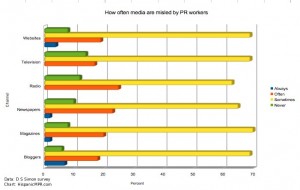
Survey: How often PR workers mislead media – click to enlarge
A recent report from a digital media and blogger placement company indicates that the relationship between public relations workers and media is poor. According to The Media Influencers Report of digital journalists, 90 percent of digital journalist respondents said they have been misled by public relations workers. Almost a quarter of them said such behavior happens often.
On average three out of four respondents said they use third party video. The highest percent among media channels, perhaps not surprisingly, was television where 93 percent of respondents said they use video provided by a third party. At the same time, when it came to video provided by public relations practitioners respondents indicated proper disclosure of content was a concern.
Twitter and Facebook top the list of social networks journalist respondents said they rely on for story ideas. Other sites that follow, they said, are LinkedIn, YouTube and Instagram.
The Media Influencers Report, the result of an online survey via Survey Monkey of 300 reporters and producers at TV, radio, newspaper, magazine, web media and bloggers, was recently released by D S Simon.
Posted by Elena del Valle on July 23, 2012
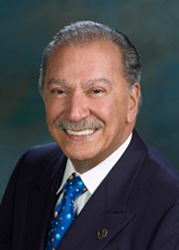
Eduardo Caballero, co-owner, Caballero Spanish Media
Photo: BigVoice Communications
Entrepreneurs Eduardo Caballero and Peter Spengler of Coral Gables, Florida are owners of Caballero Spanish Media (CSM) founded in 1973. They plan, subject to regulatory and other approvals, to buy nine television stations in Texas and Central California targeting local Mexican-Americans, growing from two staff to eight or more depending on market conditions at the time of the purchase.
Following CSM’s acquisition, the local stations are expected to broadcast a new portfolio of original Spanish language content produced in Northern Mexico and the United States for the domestic Spanish dominant Mexican consumer, offering popular and traditional music formats and health programming.
“With the broadcast media landscape undergoing drastic changes and audiences becoming more fragmented, this is a great time to offer a rich variety of music and entertainment to a growing Hispanic market and better meet the needs and wants of our audience” said Eduardo Caballero, president, CSM.
“We believe that the concentration, and homogeneity of these areas (being made up almost entirely of Mexican-Americans) gives us the unique opportunity to serve this market separately from the rest of the Hispanic population of this country.”
The Texas stations are KGBS-CA in Austin and KGMM-CA in San Antonio. The California stations are KMMC-LD in San Francisco, KMMA-CD in San Luis Obispo, KZMM-CD in Fresno, KMUM-CA in Sacramento, KMMD-CD in Salinas/Monterey, KMMW-LD in Stockton, KQMM-CD in Santa Maria, and KVMM-CD in Santa Barbara to be operated by CSM under a Local Marketing Agreement.
Currently the stations reach an estimated 1.1 million Hispanic households in Central California and 600,000 in San Antonio and Austin. The buyers goal is to grow the audiences significantly in both markets.
Comments:
Filed Under: Media
Posted by Elena del Valle on July 11, 2012

A scene from Bartali
Photos: Vme
In 2006, Rai Fiction and Endemol produced Bartali in Italy about Gino Bartali, an Italian cyclist who won the Tour de France twice. Directed by Alberto Negrin starring Pierfrancesco Favino, Simone Gandolfo, Nicole Grimaudo and Carlo Giuffre with a musical score by Ennio Morricone, described in promotional materials as one of the most influential film music composers of the 20 century, Bartali will air as a four-part miniseries on Vme beginning at 9 p.m. ET/PT July 16.
Dubbed into Spanish it may be the first time the series is airing in the United States. The program is scheduled to air for four nights and each episode is two hours long. Favino plays Gino Bartali while Grimaudo plays Adriana Bartali, Gandolfo plays Fausto Coppi and Giuffre plays Cardinale Dalla Costa.

A scene from Bartali
As a youngster Bartali nearly abandoned cycling following the death of his brother Giulio in a race. He continued cycling with the help of his brother Leone and his faith. In 1938, he won the Tour de France in honor of his brother’s memory.

A scene from Bartali
A devout Catholic, Bartali’s religious and moral beliefs led him to use his cycling talents to assist his friend Cardinal Dalla Costa and the Italian resistance during the war. In 1948, Italian Prime Minister De Gaspari asked Bartali to help ease political tensions by winning the Tour de France again and he did. Many historians believe, according to promotional materials, that the national enthusiasm that resulted from his second victory helped prevent a civil war.
Vme, a 24-hour Spanish language network partnered with public television stations, offers drama, music, sports, news, current affairs, food, lifestyle, nature and educational preschool programs. The network estimates it reaches more than 10 million Hispanic homes. Vme is the first venture of the media production and distribution company, Vme Media, Inc.
Posted by Elena del Valle on June 22, 2012
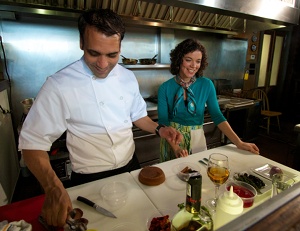
Chef Carlos Rodriguez with Margarita Martinez, host of Neighborhood Kitchens, at Orinoco, a restaurant in Boston’s South End
Photo: WGBH
Last Sunday viewers of WGBH, a PBS station in Boston, had a chance to see the premier of Neighborhood Kitchens, the television content producer’s new 30-minute program about well known neighborhood eateries in the Massachusetts area. The season will have 12 episodes, each one profiling one restaurant in Boston and Cambridge, which will air for six weeks and resume with new episodes from September through October 2012. Producers hope to eventually find private sector sponsors and expand the geographic scope of the program to most of New England.
Filming began March 2012 and is scheduled to continue throughout the summer. The series initial season will feature a heavy Latin theme with cuisine from Venezuela, Brazil, Dominican Republic, Mexico and Peru as well as an Italian restaurant and a New American restaurant with menus heavily influenced by Latino executive chefs.
For inclusion, restaurants are “considered by their overall excellence in food and service, as well as having a significant tie to the neighborhoods they reside in. The restaurants featured are all established eateries, with very strong reputations in their communities; (they) are all excellent in the cuisine they present, as well as being part of the fabric of the neighborhoods they reside in; every restaurant chosen is really beloved by the residents in their neighborhoods,” according to a station spokesperson who indicated that suggestions for restaurants may be sent to the station.
The first restaurant featured was Orinoco, a popular Nuevo Latino Cuisine style restaurant with Venezuelan roots and three locations in Boston. During the 27-minute program, Chef Carlos Rodriguez demonstrates for viewers and the program’s host how three of his dishes are prepared: a portobello arepa (a Venezuelan style cornmeal dish) with Latin truffle (a corn fungus infused) cream, a salmon marinated in panela raw sugar and a torta fluida molten chocolate cake.
Bronx born Margarita Martinez, a trained actress and graduate from New York University’s Tisch School of the Arts, hosts the series. Patricia Alvarado Nuñez is the series producer and has the final word on restaurant selection.
Neighborhood Kitchens can be seen on WGBH in Massachusetts, and parts of New Hampshire and Rhode Island. Viewers can also see the episodes online at wgbh.org/neighborhoodkitchens after the primary broadcast play. The first episode is already available at wgbh.org/programs/Neighborhood-Kitchens-1859/episodes/Orinoco-in-Bostons-South-End-39469
Posted by Elena del Valle on May 14, 2012

Nellie Gonzalez, host, Inside Mi Casa
Photos: Mi Casa Broadcasting
In January 2010, Talk Media Group, LTD., owned by Johnathan Gwyn and a private partner, established Mi Casa Broadcasting in Austin, Texas. Network executives hope it will have broad national appeal to English speaking and bilingual Latinos and be “the next ‘BET’ for Latinos.”
“Mi Casa Broadcasting is on mission to become one of the world’s preeminent media companies focusing on the new Latino American niche through cable strategic development including video-on-demand, pay-per-view, IPTV, and Wireless distribution and oversees the cable distribution,” said Gwyn, chief executive officer, Mi Casa Broadcasting, by email when asked about the company. “We want to provide advertisers a large Latino audience through properties we currently own like Dia Delivery, Latina Spice, and Please Estop It!”
Mi Casa Broadcasting, available on KTBU affiliate 55.4 in Southeast Texas, can be seen in 22 counties in the Greater Houston Area. The network also has a website, micasabroadcasting.com, where some of the programs are available for viewing.
Sixty percent of the network’s content is produced in house and 40 percent is licensed. The network staff produce eight programs per week and is working on a new program. The Mi Casa Broadcasting target audience is second generation English dominant Hispanic Americans aged 18 to 39 which network executives believe have “the biggest buying power of America.”

Johnathan Gwyn, CEO, Mi Casa Broadcasting
“We cater to your grandma who wants to speak English too,” said Gwyn. “We utilize strong social media and interactive media with our ability to send text messaging live on screen. We market through billboards, print, mobile, radio, and TV and live remotes.”
Programming includes: Dia Delivery, offering news about Latinos and things that effects them; Latina Spice, a talk show about women’s issues hosted by Denise Castro, Christina Salazar, Jennifer Peña, and Kattya Solis, according to the network website; Please Estop It, a variety show about what not to do on the web; Inside Mi Casa, hosted by Emmy Award winner Nellie Gonzalez; and The Right To Know, designed to raise awareness about issues the network programming executives believe matter to the Hispanic community.
Prior to launching Mi Casa Gwyn developed international Hispanic American media campaigns. According to his biography he was instrumental in the development and start-up of Viva Vision, a mobile TV entertainment service portal, where he worked as director of production and brand manager.
Comments:
Filed Under: Media
Posted by Elena del Valle on April 16, 2012
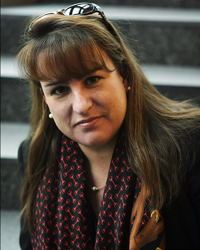
Patricia Quijano Dark, editor, Okespanol
Photo: Thatcher + Co.
A podcast interview with Patricia Quijano Dark, editor, Okespanol, is available in the Podcast Section of Hispanic Marketing & Public Relations, HispanicMPR.com. During the podcast, she discusses her publication with Elena del Valle, host of the HispanicMPR.com podcast.
Patricia was raised in New York City and her family hails from Argentina. A graduate of Columbia University she worked at publications in London, England and at El Clarin, the Argentine daily, before moving to Salt Lake City. In Salt Lake City, she worked in journalism as a freelancer and edited translations of Newsweek for the Spanish language edition.
Prior to working at OKespañol she was executive director of the Utah Hispanic Chamber of Commerce. She has served on several boards of local non-profits and is one of the co-founders of the Dual immersion Academy, a dual immersion school in Utah. She is highlighted in volume I of the book Utah Latinos and was named one of 30 Women to Watch by Utah Business magazine.
To listen to the interview, scroll down until you see “Podcast” on the right hand side, then select “HMPR Patricia Quijano Dark” click on the play button below or download the MP3 file to your iPod or MP3 player to listen on the go, in your car or at home. To download it, click on the arrow of the recording you wish to copy and save it to disk. The podcast will remain listed in the April 2012 section of the podcast archive.
Posted by Elena del Valle on April 11, 2012

Piratas, a new series airing on Vme – click to enlarge
Photos: Vme
There is good news for Spanish speaking United States audiences left hungering for more pirate fun after the last of the Pirates of the Caribbean movies. In 2010, Telecinco of Spain produced a pirates series set in the eighteenth century. Thanks to Vme Spanish speakers in the United States will have an opportunity to see 10 60-minute episodes beginning April 19 at 10 p.m.(ET/PT).

The cast of Piratas – click to enlarge
Piratas (Spanish for pirates), filmed in coastal Spain with a budget exceeding $1 million per episode, showcases the adventures of an “unabashed and philandering member of the nobility” forced to infiltrate the pirate crew of the legendary Captain Bocanegra.
Described as light-hearted and peppered with humor in promotional materials, the series follows Álvaro Mondego, a privileged member of the noble class as he is captured by Captain Bocanegra pirates, along with Carmen, his daughter, and crew. The programs are said to be filled with gorgeous ships, stinking dungeons, brave rescues, fierce battles and a daring race for riches.
Vme, a 24-hour Spanish language network partnered with public television stations, is available in 10 million homes possibly reaching as much as 80 percent of the Spanish language market.
Posted by Elena del Valle on April 9, 2012

Click to enlarge
Photos: MamásLatinas
Hoping to expand the reach of CafeMom, founded in late 2006 by Andrew Shue and Michael Sanchez with the support of lead investors Highland Capital Partners and Draper Fisher Jurvetson, earlier this year the company launched MamásLatinas targeting the Hispanic mom market.
Company executives are convinced that MamásLatinas fills a major gap in the mainstream digital and social environment. Before launching the new venue CafeMom staff conducted a major national study. According to a spokesperson, the study revealed that 92 percent of Hispanic moms across the acculturation spectrum believed there was no website that clearly met their needs. Anticipating that by 2014 one in four moms online will be of Hispanic heritage they moved forward.
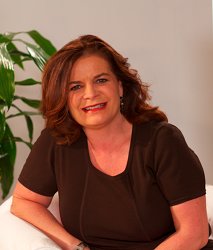
Lucía Ballas-Traynor, co-founder and executive vice president, MamásLatinas
“With the right Hispanic leadership and Hispanic lens, in the trails of the Census 2010 disclosing of Hispanic population exponential growth, launching a Latina-centric brand seemed like a win-win solution, both from a business and consumer standpoint,” said Lucía Ballas-Traynor, co-founder and executive vice president, MamásLatinas, by email.
“MamásLatinas goal is to super serve Hispanic moms across the total spectrum –languages spoken, nativity and country of origin, age, or geographic location. Our site is the first online bilingual destination for Latina moms with two core offerings, an online community and a content platform called ¿Qué Más?. The online community consists of broad-appealing groups, where conversations cover a wide array of topics (Bienvenidas, LaPlaza); and groups that specifically target moms by country of origin (Mamás Mexicanas, etc.), or by the age of their kids; or even by passion touch points (Beauty, Puro Español).”
MamásLatinas relies on 10 full-time staff writers and editors as well as freelance writers, bloggers and columnists who write 35 original English and Spanish articles a day for ¿Qué Más?, according to Ballas-Traynor who indicated that the channel provides a venue for Latina moms to find opinion pieces about topics of interest to them and what people are talking about including news and culture, fashion/beauty, food, and parenting from their cultural perspective and sensibility, in English or Spanish, or both. Twenty-one writers including two mean are listed on the site as of this writing.
To spread the word the company plans to promote the site on Google and Facebook. Additional marketing efforts being implemented include offline media partnerships, public relations and paid marketing strategies.
“We are poised to become one of the leading online destinations dedicated to Latinas by the end of the year and the leader among Latina moms. We are aggressively marketing the site and encouraging our members to tell their friends. Our number one goal for this year is to push brand awareness and new members. We know there is tremendous opportunity for growth, but we don’t yet have a firm projection for the first year,” said Ballas-Traynor.
CafeMom employs 140 people and MamásLatinas shares many of the CafeMom resources especially those in areas of Product (technology, developers and design), Research, Marketing, PR and Sales and Sales Operations.
The new New York based site has the following founding sponsors: Chevrolet, General Mills, K-Mart and Sears. CafeMom boasts a reach of 20 million at CafeMom.com, MamásLatinas, CafeMom Studios, and the CafeMom Plus Network.
Comments:
Filed Under: Media



























